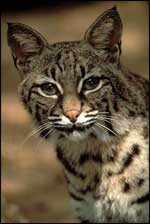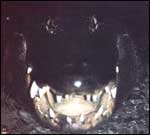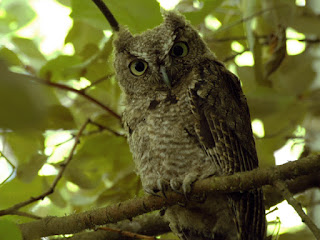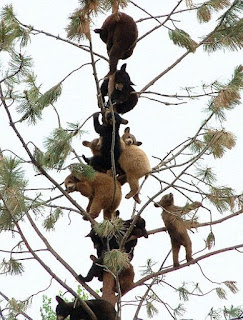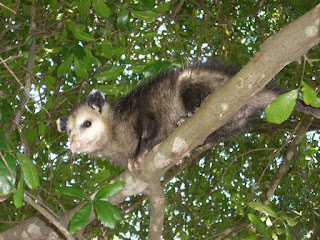Animal Eyeshine
- Details
- Category: Articles
- Published: Saturday, 09 January 2021 02:47
- Written by Super User
- Hits: 2796
One of the more interesting discussions that appears to pop up in discussing Bigfoot is the eyeshine that many researchers encounter while out in the woods at night. There is a lot of debate about what color of eyeshine Bigfoot displays, or if Bigfoot even has eyeshine at night.
Let's discuss eyeshine first, and it's so much easier for me to refer to an article posted on the Texas Parks and Wildlife website about it.
"Until primitive man discovered fire, making it possible for him to light up the night, he probably was unaware that certain animals have eyes that seem to glow in the dark. Imagine how frightened he must have been the first time he looked beyond the comforting circle of his campfire light to see a pair of shining eyes watching him from the darkness. With his limited knowledge, he didn’t know the glowing eyes were the result of reflected light—not the work of demons or supernatural creatures.
Perhaps you shared his twinge of fear the first time you saw glowing eyes in the woods, especially if you were sitting around a campfire telling ghost stories or listening to those strange night noises that stir the imagination. Even though some of you may not have had the opportunity to see a wild animal’s eyes shine, you probably have caught a glimpse of this reflected glow in the eyes of a pet dog or cat.
Eyeshine occurs when light enters the eye, passes through the rods (light receptors) and cones (color receptors) of the retina (image surface), strikes a special membrane behind the retina, and is reflected back through the eye to the light source. This special mirrorlike membrane, called the tapetum (ta-PEA-tum), is not present in the human eye. We have dark-colored cells behind our retinas, which absorb light rather than reflect it.
Most of the animals with eyeshine are night hunters, and their ability to use the available light twice, once on the way in and again on the way out, gives these nocturnal animals additional light to see by. The majority of these glowing eyes belong to mammals, but spiders, alligators, and bullfrogs are a few other creatures with reflecting eyes. Some night birds also have eyes that glow in the dark, but their eyes do not have a tapetum layer. Scientists are still trying to solve the mystery of their source of eyeshine.
An interesting sidelight is that animals with the brightest eyeshine generally have more rods and fewer cones in their retinas. As a result they have excellent night vision, but most are color-blind.
Eyeshine coloration varies from the glowing reddish orange of the alligator to the yellows and greens of the deer and cat families. Just what causes these color differences has not been documented.
Because eyeshine is directed back to the light source, you must be in the right spot to be able to see it, usually directly behind the light. To increase your chances for seeing eyeshine, watch the roadsides carefully when riding in a car at night. The headlights often are reflected in the eyes of animals by the sides of the road. While walking at night with a flashlight, shine it in an arc around you and try to catch its reflection in the eyes of night creatures just beyond its circle of light. At times dozens of spiders’ eyes will reflect from patches of tall grass. Notice the eyes of your pet dog or cat as it approaches a lighted patio area, and you may be at the right angle to see its eyes reflect.
Those of you who have a cooperative cat might like to try this experiment. On the back of a small hand mirror draw a one-quarter-inch circle. Remove the silver from the circle to form a peephole. Get as close to your cat’s eye as possible while looking through the peephole. The reflective side of the mirror should face the cat. Turn off all lights except for one small lamp located across the room from you or let a friend shine a small flashlight in your direction. Tilt and adjust the mirror until the light from the lamp or flashlight is reflected into the cat’s eye. Since the light striking the eye comes from the mirror, rays from the tapetum will be reflected back to the mirror. Through your peephole you should be able to see the red blood vessels of the retina against the sparkling surface of the tapetum.
Information on eyeshine is very sketchy, but perhaps one day further research into the subject will reveal some of its secrets. In the meantime we can but wonder about eyeshine, another mystery of nature.
Additional Information:
Ilo Hiller
1983 Eyeshine. Young Naturalist. The Louise Lindsey Merrick Texas Environment Series, No. 6, pp. 40-42. Texas A&M University Press, College Station."
So now that you have read up about eyeshine in animals, let's talk about how it affects Bigfoot research.
One of the most spoken comments I hear from people who report seeing eyeshine is that "it had red eyeshine and it was 10 feet up in the air, no animal can be that high and have red eyeshine."
Most people will adamantly stand their ground and claim that it was Bigfoot, even when you try to get them to understand, that it could possibly be a small animal sitting on a branch of a tree at that height. I personally have nearly gotten my head knocked off by people who were completely believing that what they saw was a Bigfoot standing in the dark, and all they could see was it's red eyeshine.
Well, let's take a look at the following chart about what color certain animals have when the light hits there eyes.
From the chart, we see that the following animals have red eyeshine, Owls, Whip-poor-will, Black Bears, Opossums, Porcupine and even domestic cats sometimes have red eyeshine.
Now let's step back for a second, and think about each of these animals, they all tend to either be in trees, or climb in trees.
If they are in trees, that could mean that they can get up over 10 feet from the ground, and the smaller animals can get out on branches away from the trees to appear as if they are in mid-air.
As researchers, we have to debunk everything we can, before we can even say it's "possibly" or "probably" a Bigfoot making the eyeshine, or whatever else we encounter.
Unless you can shine your flashlight on the animal making the eyeshine and confirm that it is a Bigfoot standing there, all you can do is assume what is making the eyeshine. And we all know what assume means, "When you ASSUME means that you make an ass out of you and me".
The skeptics will and do tear you apart when you ASSUME anything in this field of research, you literally have to take the scientific approach, investigate your claim, try to debunk your claim, and when you have exhausted all avenues, then, and only then, say "possibly" or "probably". Being absolutely definitive about anything will come back to bite you.


